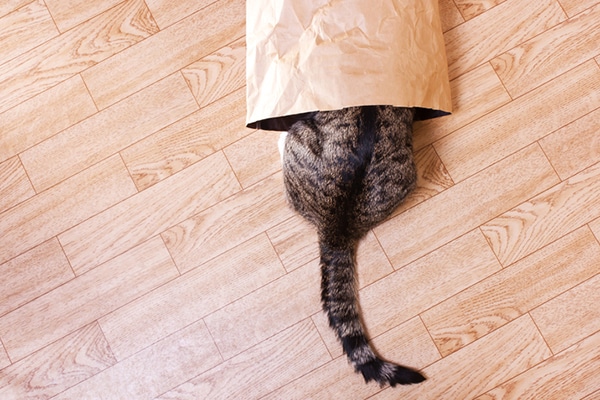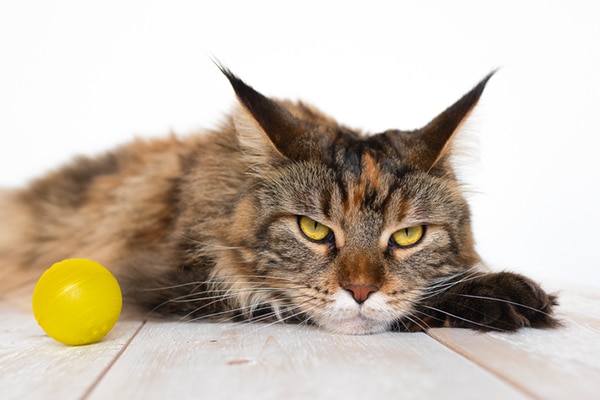You’re sitting at your home computer. You’ve got one more email to fire off before powering down for the evening. Suddenly, Catsby jumps onto the desk. He’s chewing documents, knocking pens on the floor and trying to sit on your keyboard. Maybe he’ll succeed in deleting an important spreadsheet or restarting the laptop. Your kitty has no idea he’s annoying you, yet he’s doing just that. You may not be angry, but you’re annoyed. On the flip side, humans actually do many things that annoy their cats. So, what are signs of an annoyed cat, and how do you diminish the stressors?
An annoyed cat and the telltale tail

Before exploring the reasons that cats get annoyed, let’s look at the ways in which they show us their annoyance. “The cat’s tail is rushing back and forth when he’s annoyed,” says Dr. Katherine Houpt, VMD, PhD, Diplomate – American College of Veterinary Behaviorists James Law Professor of Behavior Medicine, emeritus.
Echoing the importance of checking the tail, Dr. Kelly C. Ballantyne, Clinical Assistant Professor at the University of Illinois College of Veterinary Medicine, says, “The tail may be flicking at the end, but not yet thrashing or thumping.”
Dr. Margaret Gruen, PhD, Duke University, says pet parents should heed the signals their cats are sending: “An annoyed cat is exactly that – a cat that’s starting to give you some warnings that he or she would like you to stop what you are doing. You may see attempts to move away or a swishing tail, or a cat may use a paw placed on you.” Again, that tail is telling you something!
Other signs of an annoyed cat
Cats will use other tactics to announce their annoyance. Meowing is one way. “The annoyed cat may also make some low-pitched meows but isn’t yet hissing or spitting,” Dr. Ballantyne says.
Nuanced body language is another way to detect if your cat is annoyed. “The annoyed cat may be crouching or ducking his head into his shoulders. He may be turning his head away or leaning away from what is annoying him,” Dr. Ballantyne says. “The annoyed cat’s ears will be slightly turned back but not completely flattened to the head.”
Is your cat annoyed? A quick checklist to tell:
- Swishing (not thumping) tail
- Attempting to move away from you
- Cat is crouching or ducking head into shoulders
- Ears turned back
- Low-pitched meowing
An annoyed cat vs. an angry cat
“An annoyed cat is lower on the spectrum of fear, anxiety and stress than an aggressive cat,” Dr. Ballantyne says. “The annoyed cat may still be trying to avoid a direct conflict or fight, but if the threat continues, the annoyed cat may escalate to aggression.”
“Once a cat has switched from annoyed to angry, you will see the tail begin to thump rather than swish (or may become very stiff and still), and his ears may go back,” Dr. Gruen explains. “He may vocalize with a low growl or a hiss. Very angry cats will adopt a stiff or hunched posture, and their hair and tail may ‘puff up.’ The truth is that cats give us many warning signs before annoyance turns to anger.”
Experts agree that once you’ve determined that your cat is angry, identifying the source of the stress and quelling it can de-escalate the situation quickly. Ensuring your cat has a way of escaping what’s upsetting him is crucial. High cat trees, kitty condos and access to a quiet room can help alleviate his fear and anxiety before an annoyed cat turns angry or aggressive.
What’s most annoying to cats?
According to Dr. Ballantyne, there are a lot of reasons why cats get annoyed. “We often fail to appreciate our cats’ preferences,” she explains. “While many cat owners love to pet and snuggle with their cats, not all cats enjoy this type of physical affection. If you notice signs of annoyance during petting or snuggling, figure out another activity that both you and your cat can enjoy.”
If your cat is displaying signs of annoyance check for these culprits:
- Is there a stray cat outside?
- Is another animal blocking access to his food, water, or litter box?
- Is someone interacting with him in a way he doesn’t like?
In addition to modifying your own behavior, sometimes you’ll have to act as a referee. In a multi-cat house, there is often an antagonizer in the group. Youngsters may annoy older cats by playing too rambunctiously, and sometimes one of the cats is just a bully. Providing a quiet place, at all times, is important for all your kitties.
Since every cat is an individual, it’s important to pay attention to what annoys your cat. We know some cats don’t like their bellies touched! Some cats don’t want to be picked up!
Thumbnail: Photography © ollegN | Thinkstock.
Read more about cat behavior on Catster.com:








